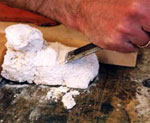Because there are variables beyond my control (clays, papers, water, mixing errors and etc) always pre test fire what you have before a big project. No guarantee can be offered that 'alternative" commercial paperclays now on the market will meet the all the performance advantages of my high performance trademark P'Clay® brand only available from licensed manufacturers/distributors.

1. Chisel bone dried porcelain paperclay "ruff'rock, gruffrock" chunk with a hammer at the bone dried state.

2.Trimming
Carveporcelain detail and trim with a fettle blade as above, or plane the edge with a flexible thin stainles steel "rib".
If you try this at the sinter( low fire under cone 032) fired state there will be no fiber in your blade.
chisel and carving methods
1. Chisel down solid chunks.
Experiment with a hammer and chisel down an air hardened solid chunk of paperclay perlite porcelain claybody. It chisels with a density a bit like soap stone at bone dry. When fired is light weight.
Smooth over and trim when done with water and a damp sponge. At any time you can correct and patch up holes, add more contour etc.
The final result can be pure porcelain if you wanted and alternative to marble or stone.
This technique needs some more research to learn the limit of how thick one can go without at least poking a stick opening underneath to make a small space to allow contraction and expansion of the form during inevitable temperature or moisture changes after completion. I have tested as thick as the above picture so far successfully. Perlite laden paperclay has less shrinkage and the ratio of the recipe ingredients must be balanced.
2. Carve on paperclays
Paperclay porcelain or china clay has a feel that is slightly different to a non paperclay. It is still plastic but the presence of tiny fibers seemed to allow me to carve a level of detail only so far. Carving on a leatherhard surface is not recommended. Rather work at soft and/or bone dry states
Of course you can rewet and soften, add, subtract as often as you like. This benefit alone makes the adaptation from traditional clay worth while.
A good way to get a final trim of ultra crisp detail in a sinter fired porcelain paperclay. "Sintering" is an extreme low temperature fire of clay to about cone 032 or even F451 to burn paper fibers out yet keeps the body quite strong , enough to carve the powdery clay remainder away and get extreme crisp detail. If you carve too much? If the base was orginally a paperclay, re-wet the chip and patch it with soft slurry. The re-sinter the patch to be sure the seal was good and carry on as if nothing happened.
Read more about these topics my article download or in my books.
See some carving in the gallery section.